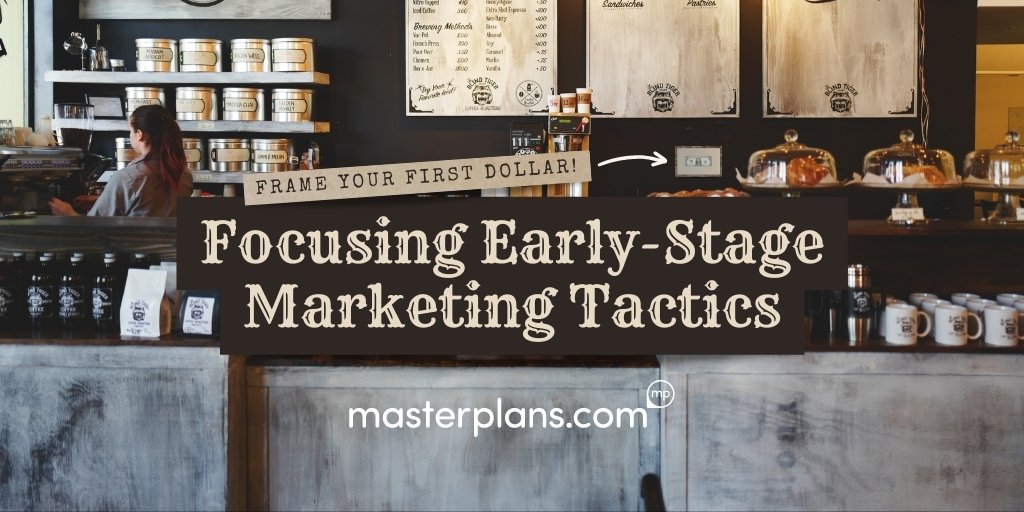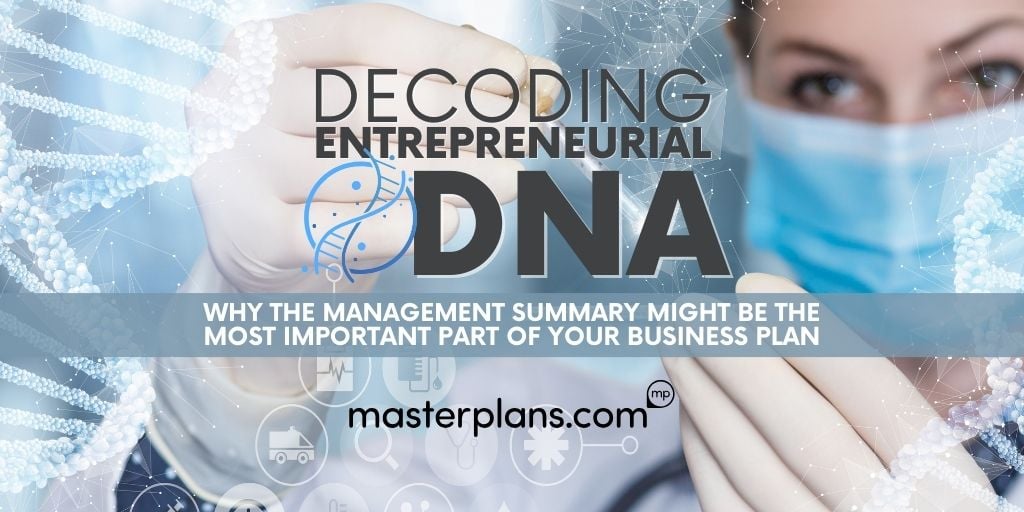How to Write a Management Summary for Your Business Plan
Entrepreneurs are often celebrated for their uncanny ability to understand others – their customers, the market, and the ever-evolving global...
12 min read
![]() Ben Worsley
Mar 1, 2023 9:00:53 AM
Ben Worsley
Mar 1, 2023 9:00:53 AM

I may be showing my age in this era of tap-to-pay, but I remember when many businesses displayed a framed one-dollar bill on the wall. Perhaps you’ve seen it before and wondered why a business owner would frame a measly dollar.
The framed one-dollar bill serves as a symbol. It commemorates the moment when a business that has been months or even years in the making finally opens its doors and renders its first transaction. For a business owner, it serves as a constant reminder that your company, no matter how prosperous it is now, once had only one dollar.
Furthermore, the importance of the framed dollar stems from the fact that your first sale will be the most difficult sale you will ever make.
Once a business is established with a number of glowing 5-star online reviews, closing a sale is as easy as saying, “look at all these happy customers who purchased from us!” However, gaining the confidence of your first customer to purchase your goods or services when you have no prior track record? That’s a true accomplishment worthy of a frame. (Side note: Closing sales is rarely easy.)
In today’s post, I hope to offer some suggestions for generating interest in your new enterprise and, ultimately, attract your first (of many) happy customers.
There are a few fundamental marketing principles that every entrepreneur should be reminded of before we dive into specific marketing strategies.
The first step in making a sale is to identify who is most likely to buy your product or service. Because if you can’t identify who you’re trying to reach, you can’t figure out how to reach them.
Fortunately, since you’re a good business planner (ahem) this is research you’ve already done.
If not, we have two resources for you to look at. The best place to start is with general market research. We’ve put together a full list of the best free and paid market research tools, scored them based on seven variables, and even provided an explanation of how to use each of them.
Once you have an idea of your general market, now it’s important to identify the behaviors of the people who makes up your ideal customer base. Enter the Customer Persona (a.k.a. Buyer Persona). A Customer Persona is a hypothetical but realistic depiction of your customer that includes their demographics, interests, behaviors, motivations, and more. Taking the time to develop good Customer Personas will help you write a stellar business plan, and they will help you create targeted marketing campaigns that will resonate with your target audience. What’s that? You haven’t created a Customer Persona yet? Masterplans has you covered there too! Not only do we have a free downloadable Customer Persona template to guide you through the process, we’ve written 50 questions to serve as writing prompts to help you create Customer Personas that are thorough and usable.
Almost every entrepreneur believes that designing a logo is one of the most important parts of growing their business. Most seek that perfect symbol that identifies and represents their company. Every entrepreneur dreams of having their logo conjure up all kinds of hidden meanings that symbolize the company’s values and origins from a single glance.
I have been a graphic designer for nearly 25 years, so allow me to let you in on a little secret: Your logo isn’t that important.
There are two reasons why I say that. First, for a logo to become genuinely memorable, like the ones you think about everyday, it takes a LOT of money. To hire a top branding company to develop a logo will cost you in the tens of thousands of dollars. And then you have to promote it. If Nike didn’t spend billions of dollars putting the Swoosh everywhere, it’d be just another shape.
And the other reason your logo isn’t that important? Because it’s likely to change. The average company goes through a major brand overhaul every 7-10 years, and then typically goes through subtle refreshes more frequently than that.
But back to my original point, what matters, especially when you’re first starting, is developing a brand. Not a logo.
Far too often, entrepreneurs use the terms “logo” and “brand” interchangeably, but they are not the same thing. A logo is part of a brand, but the brand is so much more than just a logo.
A company's brand represents its identity and values, and it helps to establish an emotional connection with customers. Colors and fonts in a brand’s visual identity can elicit emotions, set a mood, and convey a sense of professionalism or playfulness. The tone of voice, language, and overall messaging should be consistent with your company’s values and appealing to the target audience. The look and feel of a brand work together to create a distinct and memorable identity that customers will recognize and trust.
The key to building an effective brand is consistency. Everything you do in marketing must align with your brand. For it to work, a business should have a brand guide that shows exactly how to apply the brand across different media.
A few quick pieces of advice when developing your initial branding:
Your marketing plan will be the guidepost for all of your marketing efforts. While it will constantly be measured and adjusted based on what works best, your marketing plan should include the marketing tactics you will use, when you will use them, what your objectives are, and finally what your budget is.
It’s a big topic, and for many businesses, it’s not a bad idea to hire professionals. There are companies out there who will help you develop a clear marketing plan you can employ yourself, and others that actually conduct all of your marketing efforts for you.
Of course, the amount of money you have to spend on marketing will influence this decision; most new businesses spend between 2% and 5% of their annual revenue on marketing and advertising. And, depending on the industry, it could be significantly higher.
The Marketing Funnel is a model that describes the journey a potential buyer goes through before making a purchase. You’ll see some marketing funnels with three levels, some with four; they can get infinitely more complex as you begin developing your company’s individual marketing plan.
But at the most fundamental level, a potential buyer goes through three primary stages: awareness, consideration, and action. Your company’s marketing efforts should aid a potential buyer in progressing from the current stage of their buying journey to the next.

Although the specifics of each company are unique, a general rule of thumb is that customers move through the stages more rapidly if your product costs less.
Consider the purchase of a pack of gum. Perhaps you weren’t even thinking about needing gum, but something about the package catches your eye as you wait in line at the checkout. Awareness! So you grab a pack of gum and start reading the package. Consideration! Finally, you place it in your shopping cart. Action! As you can see, the whole marketing funnel took about 30 seconds.
If your item is more expensive than a pack of gum, however, the process could take much longer. For instance, at Masterplans, we know that it can take a year or longer from a customer’s first contact with our business until they make a purchase decision.
The marketing funnel is also a useful tool for identifying which potential customers are ready to make a purchase right now and subsequently honing in on them. This is especially important in the early stages of a business, when you want to focus on two things: (1) speeding up the buyers' journey (such as eye-catching packaging for your gum), and (2) the customers most ready to buy right now.
In other words, in the early stages of running your business, while on one hand you are building your funnel to nurture prospects to sustain long-term growth, you should prioritize the marketing strategies that encourage a lead to take the final step and buy your product.
How you market your business depends a lot on what you’re selling. (And you thought I was just going to say, “Make a Website!” and call it a day.) But now that I brought it up, a website is as good a place as any to discuss why there’s no one answer for any business. Sure, websites are important. But if you’re opening a single-location restaurant, for example, an online menu might not be the best way to earn your first customers.
As there is no universal approach to startup marketing, let’s look at efficient early-stage marketing strategies tailored to specific business types that are most likely to drive your first customers.
For a Direct-to-Consumer business that operates in a physical location, you need to get people in the door. Hopefully, you’ve weighed all the different variables and decided on the “perfect” location for your new business. (TLDR: There’s no such thing as a perfect location.)
Website: I already spoiled this before, but for many D2C brick-and-mortars, your website takes a backseat to other marketing channels. In general, you can probably get away with a simple website that describes your product or services (like a link to your menu if you’re a restaurant), and a clear way to find your location (map, address, and phone number.)
Online Presence: The real reason to create a website for a business like this is to have somewhere for your online presence to link to. When’s the last time you went into a business before looking it up online? But you don’t just go to their website, right? You go to their Yelp! page or their Google Local listing. So get those set up for your business right away. For D2C brick-and-mortar, these directories are your most important marketing tools.
Social Media: How you use social media will, again, depend greatly on your products, but it’s a great low-cost early marketing tactic to generate initial buzz. Opening a blowout bar? Get on TikTok now and upload a short-form video of someone getting their hair done (with a before and after, of course). Same thing if you’re opening a restaurant. Pick your signature dish and film your chef making it from start to finish. Once you start making short-form video, it's simple to share the same video across multiple social networks, so make use of Facebook reels, Instagram stories, YouTube shorts, and whatever platform comes out next. (I preferred Vine.) But you should also be aware that social media marketing will take a long time to build (unless you get fortunate enough to go viral). So don’t expect customers to start rolling in once you upload your first video.
Grand Opening Event: I think a grand opening celebration is the perfect opportunity to build early awareness of your business and give people a taste of what being a customer will be like (if you’re a restaurant, that taste is quite literal). A grand opening event could be a party, an open house, or even a free day. Almost every franchisor for whom we write business plans requires their franchisees to have a grand opening event. Yes, grand opening events cost money, often $5,000 to $10,000 depending on what you give away. But there’s a reason franchisors require it: because they work.
Signage: Remember “Field of Dreams”? You were lied to. If you build it, they will not just come, especially if they can’t find you. So make sure you have good signage from day one. Frankly, I’d say to put your sign up long before you’re open so passersby know what’s coming. Maybe they’ll tell a friend. In marketing, we call that buzz. But besides your grand marquee, there are other important ways to generate attention. Can you put up a sandwich board on a busy intersection nearby, pointing people in the right direction? Should you put up balloons or one of those inflatable tube dancers? Maybe enlist your teenager to spin around a sign? The lesson here is to get noticed.
Entrepreneurs are enamored with ecommerce. And rightly so; you can cut out the middlemen (distributors and wholesalers), save money on location costs, and reach a national and even global target audience. But in part because it’s so attractive as a business proposition, online retail is highly competitive and making it hard to stand out in order to generate initial sales. This is especially true since the buyer can't feel, taste, or try on the product before deciding to buy it.
Website: For a D2C retailer, your website must be easy-to-use and intuitive, and look great. For some companies, hiring an ecommerce website developer is the right way to go. A self-hosted website has lower ongoing and transactional costs, and you have complete control over the shopping experience. Since your business relies on customers trusting you with their financial information, you must take every precaution to protect their data when conducting online transactions. A good ecommerce website developer will charge around $30,000 for a website. Luckily, however, there are platform solutions out there that are far less expensive. The most popular is Shopify, and you can build a nice website for free (or as cheap as $160 for a premium template). Keep in mind that platforms like Shopify (and its competitors like Wix, and SquareSpace), make their revenue primarily off transaction fees. But regardless of how much you spend on your website, it goes without saying that you’re going to need one for an online ecommerce business.
Marketplaces: If you can’t beat ‘em, join ‘em. No matter what you're selling, it can be challenging to reach customers when you're first starting out a direct-to-consumer brand. Having your product listed on marketplaces like Amazon, Etsy, and eBay in addition to launching your direct-to-consumer website is a smart move. Even though they take a sizable percentage of your sales (typically 15% or more), once you have a customer you can promote to them through your direct-to-consumer website by creating a loyalty program.
Crowdfunding: We’ve written before about how we’re a bit skeptical about using crowdfunding to fund your startup. They frequently require high costs in terms of rewards, and require an all-or-nothing approach that can leave you empty handed. But for all their challenges as a primary funding source, crowdfunding websites like Kickstarter and Indiegogo are a great way to get your first orders. You can generate revenue prior to placing your first inventory order, and launch your product out into the wild to build sales.
Promotions: For online D2C, you almost always need to offer some kind of promotion to get your first customers. Consider a BOGO offer, or maybe an add-on complementary item. It can also help to offer a discount from your regular price, but that can be challenging to communicate for a new product.
Online Advertising: Most ecommerce websites generate traffic (and sales) through online advertising. The deciding factor between utilizing Google ads (the industry leader by a mile), or something like Twitter, Facebook, or other social media ads will depend on who your audience is and (you guessed it) what you’re trying to sell them.
Influencers: Influencers are big business, and that is only made more prominent for online retailers. An influencer can show your product being used and endorsed by someone prominent. However, it should be cautioned that social media influencers are expensive. Unless your product is extremely expensive, don’t expect to send a sample product to an influencer and think they’ll promote it for free. Even micro-influencers (those with 50,000 or less followers) charge $100 to $500 per post. And a mega-influencer (over 1 million followers)? They charge $10,000 or more for a single post! It’s a perfectly valid way to drive customers to your business; just make sure you budget for it from the outset.
As a B2B service-based company, we are probably best suited to talk about B2B marketing. But let me be the first to tell you that I’ve been doing this for years, and learn something new almost every day.
Website: For a B2B service, your website is going to be the primary source of your leads. You should put together a website that makes it clear to your business customers why they need your product. B2B products typically have high price points, and most B2B buyers will perform extensive research before they make a purchase decision. So making sure your website is clear about your product is important. But what’s more important than that? Making sure the customers find you in the first place. This means focusing on search-engine optimization (SEO). Following SEO best practices will help you show higher in search engine results pages (SERPs), and that means more hits. And more hits will (hopefully) mean more sales. I can tell you from experience that SEO is complex. A lot of the time, even the experts are just making reasonable guesses because Google and Bing (the top two search engines), are very secretive about their ranking algorithms. The one thing I can say is that anyone who tells you that they can quickly and easily help you create an SEO website either has no idea what they’re talking about or is lying (it’s not easy, nor is it quick). There are no ways to “trick” the search engines. The best way to increase website traffic is to create content that meets the needs of those who are searching for it.
Content Marketing: Which brings us to content marketing. What we marketers used to call “blogging” has gotten a lot more extensive in the last few years. B2B marketers spend a lot of time developing content marketing campaigns that attract potential customers and ultimately drive purchase. Content marketing includes articles, resources, templates, podcasts, infographics, and more. These are all examples of “inbound” marketing: a customer-first approach to create experiences that attract customers by meeting their needs and interests. (In contrast, “outbound” marketing consists of things like television commercials, billboards, and print advertisements, none of which I have mentioned in this blog as good ways to get your first customers because of their prohibitive costs.)
Networking: When trying to sell a service to another business, there’s no better place to start than your professional network. If you’re a consultant going out on your own, you will already know some key players in your industry. Additionally, websites like LinkedIn are making it easier to connect with professionals than ever before.
B2B product sales might be the most challenging first sales to make of them all. You’re likely trying to sell long-term contracts to established players who may already have a solution for what you’re offering.
Website: Creating a website that makes it easy for your B2B customers to view your product catalog and attributes is as important here as it is for B2B services. B2B product buyers, whether they are manufacturers or distributors, will perform extensive research before making purchase decisions.
Trade Shows: Trade shows have taken a hit over the last few years, especially due to the pandemic, but they are beginning to take hold once again. An industry trade show or conference is a great way to meet customers and introduce new products, and it doesn’t hurt that you can take these potential buyers out to dinner.
Networking: Most B2B product entrepreneurs don’t just stumble into their new business; typically they have worked in the industry at some level, possibly even for a company that is now your competitor. Reach out to your contacts (but of course obey those non-competes; you never want to burn bridges in relationship marketing) and make sure they know you’ve gone out on your own.
As you move forward with your marketing strategy, your focus can shift from the bottom of the funnel to the middle and the top. But as you communicate with potential buyers, keep in mind that telling stories is only part of marketing; it’s just as important to listen to your customers so you can fine-tune both your product and your message.
But when you first open, it is best to target the customers who are most likely to buy now. Take the time to truly understand who these customers are and start building a brand that entices them. And remember, it is never too early to begin marketing: Building anticipation before your launch can lead to demand from the moment your doors open.

Entrepreneurs are often celebrated for their uncanny ability to understand others – their customers, the market, and the ever-evolving global...

Despite growth in sectors like artificial intelligence, venture capital funding has seen better days. After peaking at $347.5 billion in 2021, there...

Most people think of a professional business plan company primarily as a "business plan writer." However, here at Masterplans, we choose to approach...